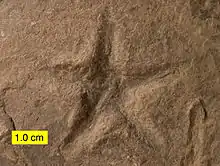Asteriacites
Asteriacites is the name given to five-rayed trace fossils found in marine sedimentary rocks (Mángano et al., 1999; Wilson and Rigby, 2000). They record the burrows of ophiuroid and asteroid sea stars on the sea floor. Asteriacites are found in European and American rocks, from the Ordovician period onwards, and are especially numerous in the Triassic and Jurassic systems.[1][2][3]
| Asteriacites | |
|---|---|
 | |
| Asteriacites lumbricalis, a trace fossil of an ophiuroid echinoderm; Carmel Formation (Middle Jurassic), near Gunlock, Utah | |
| Trace fossil classification | |
| Kingdom: | Animalia |
| Phylum: | Echinodermata |
| Superclass: | Asterozoa |
| Ichnogenus: | †Asteriacites Mángano et al., 1999 |
| Ichnospecies | |
| |
Dense assemblages of Asteriacites ('Asteriacites beds') are considered proxies for marine settings, low bioturbation intensity, shallow tiering, high sedimentation rate and/or event-bed deposition, significant levels of hydrodynamic energy, and low predation pressure.[3]
Gallery
 Asteriacites from the Devonian of northeastern Ohio; this trace was made by an asteroid echinoderm
Asteriacites from the Devonian of northeastern Ohio; this trace was made by an asteroid echinoderm Bedding plane view of Asteriacites from the Snapper Point Formation (Permian), New South Wales
Bedding plane view of Asteriacites from the Snapper Point Formation (Permian), New South Wales
References
- Mángano, M.G.; Buatois, L.A.; West, R.R.; Maples, C.G. (1999). "The origin and paleoecologic significance of the trace fossil Asteriacites in the Pennsylvanian of Kansas and Missouri". Lethaia. 32: 17–30. doi:10.1111/j.1502-3931.1999.tb00577.x.
- Wilson, M.A.; Rigby, J.K. (2000). "Asteriacites lumbricalis von Schlotheim 1820: ophiuroid trace fossils from the Lower Triassic Thaynes Formation, central Utah". Ichnos. 7: 43–49. doi:10.1080/10420940009380145. S2CID 129314190.
- Baucon, A., Neto de Carvalho, C. 2016. Stars of the aftermath: Asteriacites beds from the Lower Triassic of the Carnic Alps (Werfen Formation, Sauris di Sopra), Italy. Palaios 31. Abstract available at http://www.tracemaker.com
| Wikimedia Commons has media related to Asteriacites. |
This article is issued from Wikipedia. The text is licensed under Creative Commons - Attribution - Sharealike. Additional terms may apply for the media files.